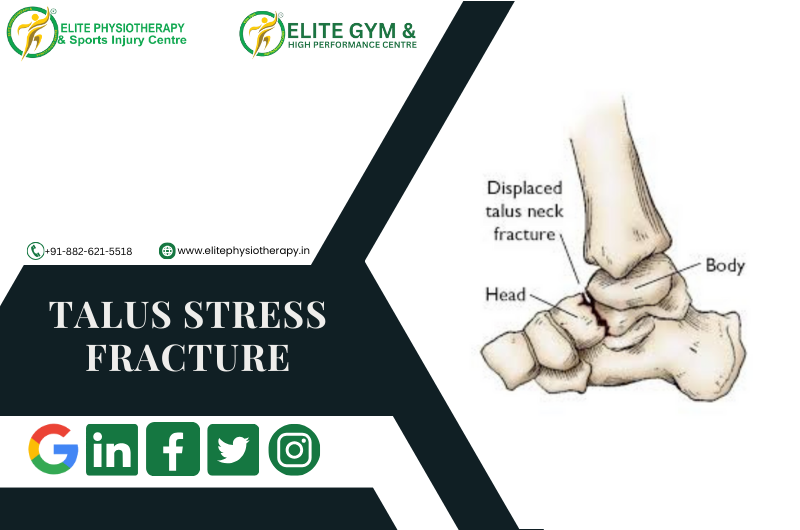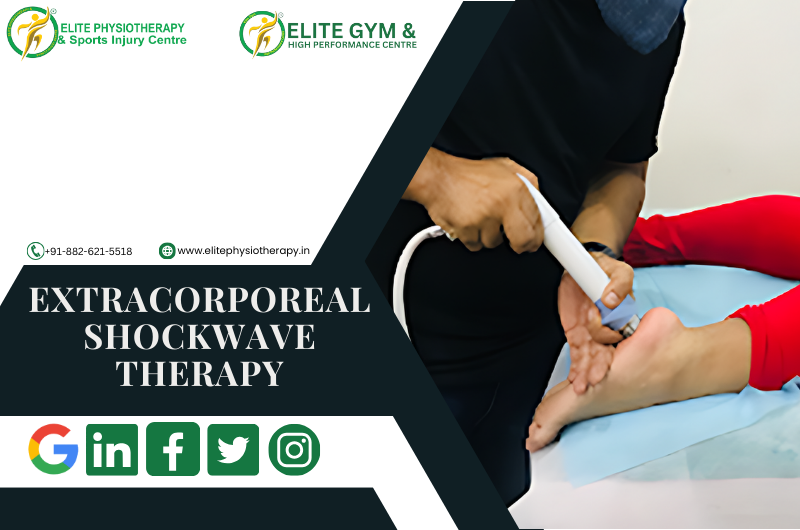Despite being very rare, stress fractures of the talus are serious injuries that need careful attention and care. The talus, a crucial bone in the ankle that connects the leg and foot, is essential for both weight bearing and movement. At Elite Physiotherapy and Sports Injury Centre, we provide cutting-edge, customized treatment for conditions like talar stress fractures, guaranteeing our patients a speedy recovery.
What Causes a Stress Fracture of the Talus?
When misuse and repetitive stress surpass the bone’s capacity for self-healing, stress fractures result. As the main weight-bearing bone in the ankle, the talus is vulnerable to these injuries in people who participate in high-impact activities or have poor biomechanics.
Common Causes
- Overuse and Repetition: High-impact sports like basketball, gymnastics, ballet, and running can lead to overuse and repetition.
- Inappropriate Training Techniques: Abruptly increasing the amount or intensity of training.
- Foot biomechanics: abnormalities such as flat feet or overpronation.
- Footwear: Poorly supportive shoes that are worn out or inadequate.
- Bone Health Issues: Osteoporosis and vitamin D insufficiency are conditions that affect bone health.
Example of Mechanism of Injury
Repeated microtrauma to the talus occurs when a marathon runner trains on uneven terrain without adequate rest intervals. A stress fracture occurs when this stress eventually exceeds the bone’s ability to heal itself.
Signs and Symptoms
For prompt intervention, it is essential to recognize the symptoms of a stress fracture. Patients who have a talar stress fracture frequently show:
- Deep, Persistent Pain: Ankle pain that improves with rest, especially when you’re not carrying any weight.
- Swelling: The ankle joint is noticeably swollen.
- Tenderness: Pain along the length of the ankle joint or when the talus is palpated.
- Stiffness: Difficulty with dorsiflexion or plantarflexion and decreased ankle mobility.
- Gait Alteration: A change in gait brought on by discomfort, such as limping.
Diagnosis of Talus Stress Fractures
To guarantee precise evaluation and diagnosis, Elite Physiotherapy and Sports Injury Centre combines clinical knowledge with cutting-edge diagnostic methods.
1. Detailed Physical Examination
- Ankle bruising, edema, and limitations in movement were noted.
- Finding painful spots on the talus by palpating it.
2. Functional Assessment
- examination of gait to identify biomechanical anomalies or compensatory patterns.
- Tests of balance and weight-bearing are used to assess functional limitations.
3. Special Physiotherapy Tests
- Certain stress tests to determine the precise site and type of injury. The goal of these studies is to replicate symptoms by subjecting the talus to controlled stress.
4. Imaging
- Even though physical examinations are thorough, advanced imaging tests like CT, MRI, or X-rays could be suggested to confirm the diagnosis and gauge the severity of the damage.
Management of Stress Fracture of the Talus
A combination of rest, sophisticated physiotherapy techniques, and a gradual return to exercise are necessary for effective management. For the best possible rehabilitation, we at Elite Physiotherapy and Sports Injury Centre offer state-of-the-art, patient-centered care.
Initial Management
- Activity Modification: To lessen talus tension and stop more damage, refrain from weight-bearing activities.
- Immobilization: Restricting movement and promoting recovery through the use of braces or supportive footwear.
- Pain and Swelling Control: Using cryotherapy, or cold therapy, to reduce inflammation.
Comprehensive Physiotherapy Management
1. Advanced Modalities for Pain Relief and Healing
We use cutting-edge technologies to enhance results and accelerate recovery:
- Shock Wave Therapy: A non-invasive treatment that promotes bone repair, lessens discomfort, and enhances circulation in the afflicted area is shock wave therapy.
- Capacitive Resistive Energy Transfer (CRET) Therapy: Using specific electromagnetic waves, Capacitive Resistive Energy Transfer (CRET) therapy improves tissue repair and lowers inflammation.
- Super Inductive System: The Super Inductive System uses electromagnetic stimulation to reduce pain and encourage deep tissue healing.
- High-Intensity Class 4 Laser Therapy: Promotes bone healing, lowers inflammation, and stimulates cellular repair.
- Cryotherapy: Applying cold to relieve severe pain and swelling.
- Hydrotherapy: A water-based treatment that increases joint strength and mobility without putting undue strain on the talus.
2. Progressive Strengthening and Weight-Bearing
- As the pain goes away, gradually increase the amount of weight-bearing workouts.
- To regain stability and avoid further injuries, do strengthening exercises that focus on the ankle, foot, and surrounding muscles.
3. Exercises for Mobility and Flexibility
- Ankle flexibility and range of motion can be enhanced with mild stretches.
- methods for reducing stiffness and reestablishing regular motion.
4. Training for Proprioception and Balance
- exercises intended to decrease the chance of re-injury by enhancing ankle stability and coordination.
- Balance boards and stability trainers are examples of tools that can improve neuromuscular control.
5. Gait Retraining
- Targeted treatments aimed at reversing abnormal gait patterns brought on by pain or compensating after the injury.
- Instruction on appropriate foot placement and biomechanics.
6. Education of Patients
- Advice on how to prevent recurrence through appropriate footwear, training methods, and activity adjustment.
- Suggestions for bone health, hydration, and diet to aid in general recuperation.
Why Choose Elite Physiotherapy and Sports Injury Centre?
At Elite Physiotherapy and Sports Injury Centre, we provide unmatched care by fusing cutting-edge technology with our expertise. Our team of highly skilled physiotherapists develops individualized treatment programs based on the particular requirements of every patient. Our advanced technologies, thorough evaluations, and patient-centered approach guarantee a quicker recovery and long-term well-being.
State-of-the-art methods and caring treatment can help you at every stage, whether you are an athlete ready to resume your sport or an active person looking for pain relief.
Take the First Step Toward Recovery
Don’t delay if you have ankle pain or think you may have a talar stress fracture. To start your path to an active, pain-free living, stop by Elite Physiotherapy and Sports Injury Centre. Our skilled team and advanced treatments are here to support you in achieving the best possible recovery.



